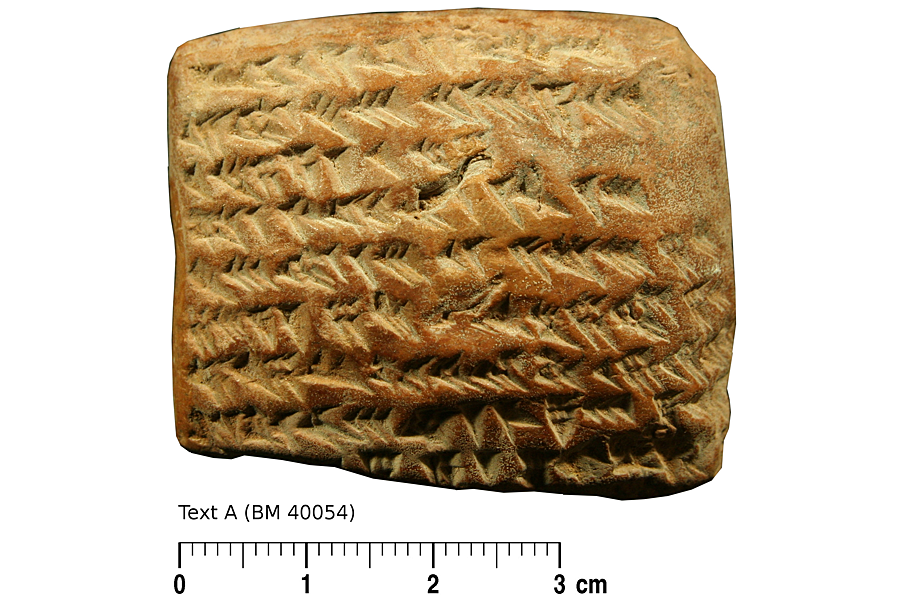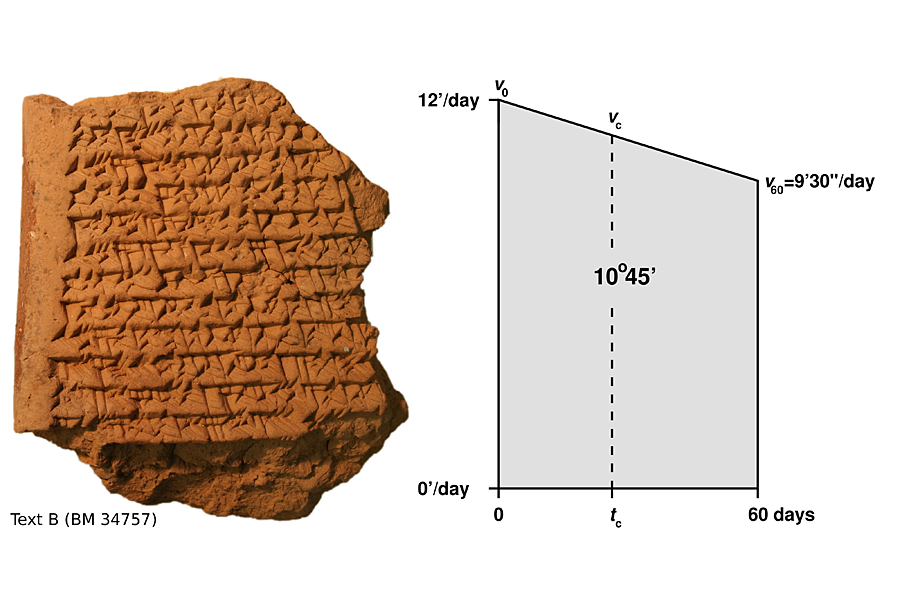Were ancient Babylonian astronomers math whizzes? Check out these tablets.
Loading...
Rudimentary calculus may have been born over a thousand years earlier than previously thought.
Babylonian clay tablets dating to 350 to 50 B.C.E. display astronomers' calculations as they tracked Jupiter across the sky. And they did it using geometric calculations.
The technique, tracking the distance a body travels from a graph of its velocity against time, was thought to have been developed around 1350 in England. But an astroarchaeologist describes the same type of computations on these older tablets in a paper published Thursday in the journal Science.
On some of the tablets, the ancient astronomers describe a trapezoid, a rectangle with a slanted top. If the astronomers were to graph the velocity of Jupiter's path across the sky against time, that trapezoid would have appeared as the area under the curve.
"The Babylonians really understood that if you compute the area of this figure, the area of this trapezoid that describes how the velocity changes with time, this area will give you the distance traveled by Jupiter," study author Mathieu Ossendrijver tells The Christian Science Monitor in an interview. "It's not unlike what we do in integral calculus when we compute areas under such curves."
"There's no other evidence from antiquity that astronomers or other scholars were doing that, plotting something against time, in this case the velocity of a planet, and doing computations with that figure," he says.
Jupiter would have been particularly significant to the Babylonians because it was thought to be the manifestation of their supreme god, Marduk. They believed that the planet's position in the sky could predict a plentiful grain crop, or the level of the river Euphrates, for example.
The astronomers doing these early calculations would have likely been priests, Dr. Ossendrijver says. And "a lot of their astronomy was done for astrology." So knowing where Jupiter would be at a given time would have been important.
From the perspective of someone standing on Earth, Jupiter doesn't travel across the sky at a uniform speed. The planet gradually slows down from the first day it appears to the 60th. So it would have been difficult for priests to predict its position in the sky without advanced mathematical algorithms.
"It shows a surprising level of insight and sophistication among these Babylonian astronomers," Ossendrijver says. "It is a highly modern way of dealing with motion that was reinvented more than a thousand years later."
The abstract, geometrical ideas behind this technique stand out in history. "Such concepts have not been found earlier than in 14th century European texts on moving bodies," Alexander Jones, a historian at New York University who was not associated with the study told Science. "Their presence … testifies to the revolutionary brilliance of the unknown Mesopotamian scholars who constructed Babylonian mathematical astronomy."
Noel Swerdlow, a historical researcher at Caltech who was not involved in the study, told NPR, "They were very, very smart, and the more we learn of what they did, the more impressive, the more remarkable it becomes."
The tablets themselves don't seem all that impressive. "As an object, they don't look very attractive," Ossendrijver says. "The tablets are really just chunks of clay. They were inscribed by the astronomers while they were still soft, and then they let them dry. I assume that when they dried up, they put them in their library."
"There are no drawing on these tablets, there's only text," he says. The trapezoid is only described.
Some of these tablets have been sitting in the British Museum for decades unexplained. Ossendrijver had been studying four of the tablets described in the paper. They all described the trapezoid but didn't fully explain the computations behind that figure.
But in 2014, a retired archeologist gave Ossendrijver images of another tablet. "This new tablet describes the motion of Jupiter," Ossendrijver says.
Dubbed text A in Ossendrijver's paper, the fifth tablet does not mention the trapezoid. It does, however, describe how the velocity of Jupiter changes over time. And that description "exactly matches the figure that's described on the other tablets," he says.
When the form of writing on these tablets, cuneiform script, became archaic, some aspects of Babylonian culture was lost. Things like a base-six number system, like the one we use to tell time, and the division of the sun's path across the sky into zodiac signs survived. But this precursor to calculus likely was lost along with these tablets.
"Babylonian astronomy was taken up by Greeks and eventually our astronomy is rooted in that ancient astronomy," Ossendrijver says. "Babylonia seems like an exotic dead culture with no relevance, but actually, it's part of our heritage."









